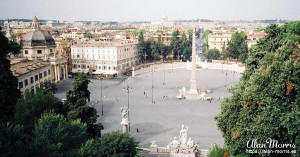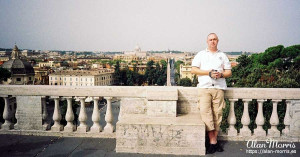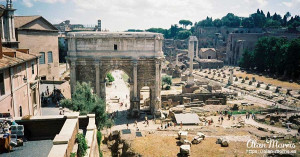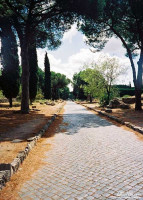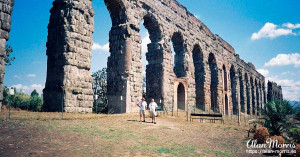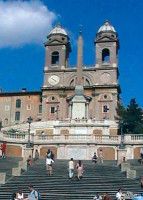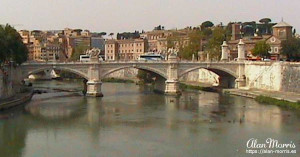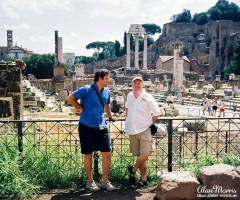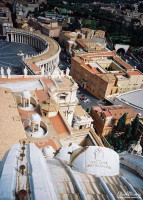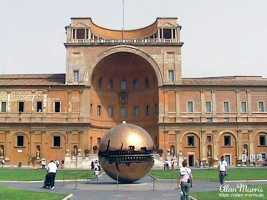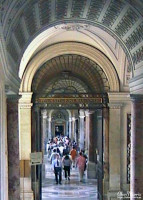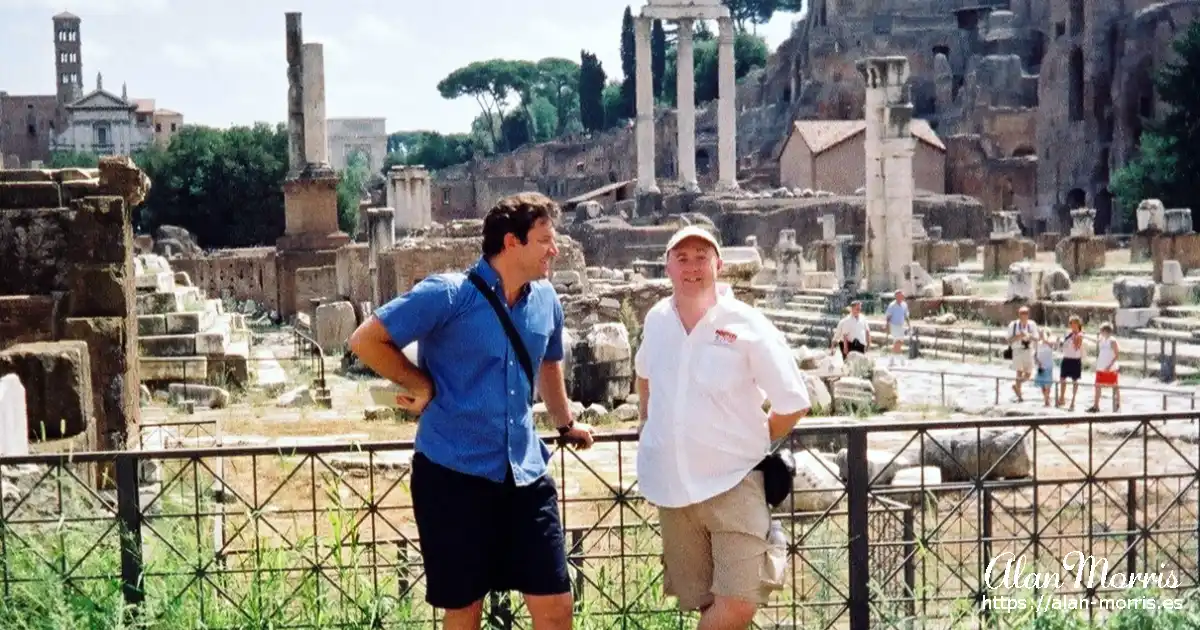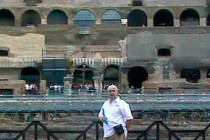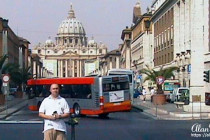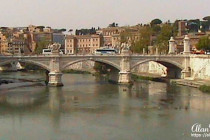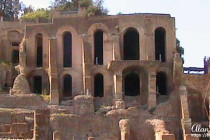In 2003, I went to Rome with my friend Paul Dunne on a long weekend trip. I had never been to Italy before and was looking forward to spending time in Italy's capital city, Rome.
While in Rome, we originally meant to look around by ourselves, as we stayed in the middle of Rome within walking distance of many things. After spending our first day walking around, we met a man in the Forum who told us he was a tour guide and offered to show us around the Forum for free. He said we could leave him a tip if we enjoyed the guided tour. He was fantastic, and we booked him for a few days so he could show us around many other places. During our time there, we visited the following places.
Near the Colosseum in Rome is a rectangular area surrounded by the ruins of several important ancient government buildings. The citizens of Rome called this space, originally a marketplace, the Forum. We had just arrived at the forum when we met a tour guide who showed us around. It was a fascinating place to visit, and it was made a lot more interesting by his stories and knowledge about it.
The Colosseum, also known as the Flavian Amphitheatre, is an oval amphitheatre in the centre of the city of Rome. It is built of travertine limestone and brick-faced concrete, and when it was built, it was the largest amphitheatre in the world, holding fifty to eighty thousand spectators. The Colosseum is situated just east of the Roman Forum.
Construction began under the emperor Vespasian in AD 72 and was completed in AD 80 under his successor and heir, Titus. Further modifications were made during the reign of Domitian. These three Roman emperors are known as the Flavian dynasty, and the amphitheatre was named in Latin for its association with their family name, Flavius. The Colosseum could hold an estimated 50,000 to 80,000 spectators at various points in its history over the centuries, having an average audience of some 65,000.
It was used for gladiatorial contests and public spectacles such as mock sea battles (for only a short time, as the hypogeum was soon filled in with mechanisms to support the other activities), animal hunts, executions, re-enactments of famous battles, and dramas based on Classical mythology. The building ceased to be used for entertainment in the early medieval era. It was later reused for housing, workshops, quarters for a religious order, a fortress, a quarry, and a Christian shrine.
Although substantially ruined by earthquakes and stone robbers, the Colosseum is still an iconic symbol of Imperial Rome and is listed as one of the New 7 Wonders of the World. It is one of Rome's most popular tourist attractions and also has links to the Roman Catholic Church, as each Good Friday, the Pope leads a torchlit "Way of the Cross" procession that starts in the area around the Colosseum. In 2018, it was the most popular tourist attraction in the world, with 7.4 million visitors. The Colosseum is also depicted on the Italian version of the five-cent euro coin. The Colosseum was fascinating and more significant than I imagined. We hired a set of headphones that described what we were looking at as we walked around.
The Pantheon doesn't look much from the outside, but inside, it is beautiful. We got dizzy looking up at the ceiling and through the Oculus on the roof. The Pantheon is a former Roman temple, now a Catholic church (Basilica of St Mary and the Martyrs), on the site of an earlier temple commissioned by Marcus Agrippa during the reign of Augustus. It was completed by the emperor Hadrian and probably dedicated about 126 AD. Its date of construction is uncertain because Hadrian chose not to inscribe the new temple but rather to retain the inscription of Agrippa's older temple, which had burned down. The building is cylindrical with a portico of large granite Corinthian columns under a pediment. A rectangular vestibule links the porch to the rotunda under a coffered concrete dome with a central opening (oculus) to the sky. Almost two thousand years after its construction, the Pantheon's dome remains the world's largest concrete dome with no reinforcement. The height of the Oculus and the diameter of the interior circle are the same, 142 feet. The Pantheon is a state property managed by Italy's Ministry of Cultural Heritage, Activities and Tourism.
The Papal Basilica of Saint Peter is a church built in the Renaissance style in Vatican City. Designed principally by Donato Bramante, Michelangelo, Carlo Maderno, and Gian Lorenzo Bernini, St Peter's is the most renowned work of Renaissance architecture and the largest church in the world. While it is neither the mother church of the Catholic Church nor the cathedral of the Diocese of Rome, St Peter's is regarded as one of the holiest Catholic shrines. Catholic tradition holds that the basilica is the burial site of Saint Peter. Saint Peter's tomb is supposedly directly below the basilica's high altar. A church has stood on this site since the Roman emperor Constantine the Great. The old St Peter's Basilica dates from the 4th century AD. Construction of the present basilica began on 18 April 1506 and was completed on 18 November 1626. The pope presides at several liturgies throughout the year within the basilica or the adjoining St. Peter's Square.
While in Rome, we looked around and climbed up to St Peter's Basilica. The steps going up were pretty steep, and because they were curling around the inside of the dome and the dome was sloped, you were always walking slightly bent and to one side. The view from the top was worth it, and I would advise anyone to do it if they are in Rome.
Coins are purportedly meant to be thrown into the fountain using the right hand over the left shoulder. This was the theme of the film Three Coins in the Fountain. An estimated 3,000 euros are thrown into the fountain each day. In 2016, an estimated €1.4 million was thrown into the fountain. The money has been used to subsidise a supermarket for Rome's needy. I, of course, threw coins into the fountain in the correct fashion.
The Appian Way is one of the ancient republic's earliest and strategically most important Roman roads. It connected Rome to Brindisi in southeast Italy. Its importance is indicated by its common name, "Appia longarum Regina viarum" or "the Appian Way, the queen of the long roads". The road is named after Appius Claudius Caecus, the Roman censor who began and completed the first section as a military road to the south in 312 BC during the Samnite Wars.
The Romans constructed aqueducts throughout their Republic and later Empire to bring water from outside sources into cities and towns. The aqueduct water supplied public baths, latrines, fountains and private households. The remains of the aqueduct that Paul and I were shown were just outside the city of Rome and were very impressive.
The Catacombs of Rome are ancient underground burial places. There are at least forty, some discovered only in recent decades. Though most famous for Christian burials, either in separate catacombs or mixed, people of all Roman religions are buried in them, beginning in the 2nd century AD, mainly as a response to overcrowding and shortage of land.
The original Roman custom was cremation, after which the burnt remains were kept in a pot, ash chest or urn. From about the 2nd century AD, inhumation (burial of unburnt remains) became more fashionable in graves or sarcophagi, often elaborately carved, for those who could afford them. Christians also preferred burial to cremation because they believed in bodily resurrection at the Second Coming.
Paul and I had a grand tour of the Catacombs, which you can't usually do. The tour guide we met in the forum took us into areas the public never goes to, and the monks who look after the site hardly ever see. When he was a young man, he got lost in the catacombs for many days while working for the monks. Because of this, he is allowed to go in on his own. He told us to hang back from our tour guide as we started the tour, and he would collect us. We did this, and as we walked at the back of the group, we were grabbed by him exiting a tunnel we had not seen in the dark. He pulled us down an unlit tunnel and around a corner a short way in. We waited for the noise of the group we had been with to fade, and then he lit a torch and took us into deeper levels of the catacombs that the public never saw. We were surrounded by hundreds of skeletons in alcoves in the walls, and he showed us around many chambers before we rejoined the back of the tour group and then left to continue our journey around Rome's other sights.
The Spanish Steps are steps climbing a steep slope between the Piazza di Spagna at the base and Piazza Trinità dei Monti, dominated by the Trinità dei Monti church at the top. The monumental stairway of 135 steps was built with French diplomat Étienne Gueffier's bequeathed funds of 20,000 scudi between 1723 and 1725, linking the Trinità dei Monti church that was under the patronage of the Bourbon kings of France, located above and the Bourbon Spanish Embassy to the Holy See, located below in Palazzo Monaldeschi. Architects Francesco de Sanctis and Alessandro Specchi designed the stairway.
The Santissima Trinità dei Monti church, often called merely the Trinità dei Monti, is a Roman Catholic late Renaissance titular church. It is best known for its commanding position above the Spanish Steps, which lead down to the Piazza di Spagna. The church and its surrounding area are French State property.
Paul and I very nearly spent a lot longer here than we wanted to. We had just arrived and saw some large Italian men at the door. I thought they were doormen watching visitors to the church, so I went to look inside it. As I approached them, I removed my hat, a sign of respect I have always followed when entering a church, even though I am not religious. The two suited men who saw me do this thanked me, showed me into the church, and showed me to a seat. Only a short while after being seated did I realise that I had walked in on a private wedding ceremony. With as much quiet as possible, I snuck back out just before the doors were closed. Later, I discovered that ceremonies in this church can last for up to four hours and that if I hadn't left when I did, I would have had to sit through the entire ceremony.
After spending a fantastic weekend in Rome, I often re-watch the Monty Python film The Life of Brian. Whenever I watch the film, I ask myself, "What did the Romans ever do for us?" I have to say a lot; the Romans did a lot for us, and they certainly gave me a weekend full of great memories. I will go back one day.
Rome Photos.
These photos are from my trip to Rome in 2003.
Click on any image to see a larger version of the image with a description. Use the navigation below the thumbnail images to see the previous set of images, the next set of images, or the previous or following photo albums.
